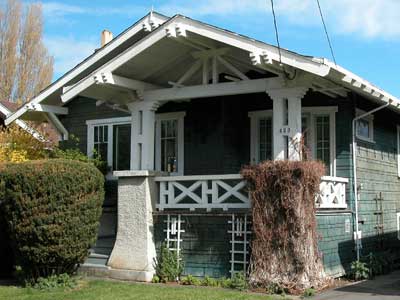Heritage Register
Fairfield
423 Durban Street
Built
1911-12
Heritage-Designated 2005
For: Bungalow Construction Co.
Designer/Builder: Bungalow Construction Co.

ARCHITECTURE:
This house is one of Victoria’s most distinctive examples of the California Bungalow, a variant of the Craftsman style, in the most significant streetscape of such houses in Victoria. It is 1-storey, with a low-pitched front-gabled roof and Japanese-style gabled entry porch with a complex roof truss on paired square supports on stuccoed battered piers. The roof has paired stepped brackets with triangular elbow braces in both gables and wide open eaves with exposed raftertails. The double-coursed shingle cladding has always been stained dark green. There are two stuccoed chimneys, and a gabled cantilevered square bay on the left side. The interior, also designated, includes: red-stained woodwork, beams and panelling; built-in sideboard and bookcase with A&C hardware; painted dining room frieze; and breakfast nook off the kitchen with built-in table and bench seats.
The Bungalow Construction Co, one of Victoria’s most prominent pre-WWI speculative housing companies, began life as Victoria Bungalow Construction Co, but owners/managers F.S. Bonnell and C.G. Walsh parted company with their main designer/builder J. Lennox Wilson and in 1912 formed the BCC. They used several architects, including American Milo S. Farwell (194 Olive St, Fairfield) and Englishman Ralph Berrill (435 Kipling St, Fairfield). However, the majority of their houses for which an architect has been identified were designed by Seattle architect E.E. Green (451 Durban St, 162 Robertson St, Gonzales).
Jud Yoho’s Bungalow Magazine from Seattle published two articles about BCC, the first in January 1913 entitled Who’s Who Among the Bungalow Builders: “From the beginning, the new company specialized in five and six room bungalows, designed with the idea of minimizing the labour of housekeeping and following in a general way the California idea, with adaptations to meet the slightly different climatic requirements.” Besides the eight houses on Durban, they also built on Kipling and Carnsew Sts, and Pinewood Av. The 1914 city directory advertised the BCC as dealing in real estate, as home builders and mortgage brokers. By 1915, the company was no longer functioning.
President and chief builder Casey Walsh (c.1883-1957) was born in Lindsay, ON, and apprenticed as a builder. He spent a number of years in the brokerage and construction business in California, came to Vancouver in 1900, and Victoria about 1910. Walsh fought in Europe in WWI, and returned to Victoria as a builder. A member of the Pacific Club, he died in Victoria in 1957.
ORIGINAL OCCUPANTS:
It is rumoured that this house was built specifically for the BCC’s Frank Bonnell and his wife Jessie, which would explain the many special features. Managing director Francis Bonnell (1881-1954) was born in St. John, NB, and came west in 1902. In 1905 he formed Bonnell, Howe Co in Vancouver, dealing in brokerage and finance. After leaving the BCC, Frank joined Hickman-Tye Hardware Co in Victoria and eventually became vice-president. He retired after 42 years.*
The Bonnells owned the house but never lived here. Directories list draftsman James T. Greig in 423 Durban in 1915 and William W. Laing, a binder in the BC government printing office, in 1917-18. But it was Jessie Bonnell who sold it to John Duncan McBeath in 1919.
OTHER OCCUPANTS:
Johnny McBeath (1886-1973) was born in Esquimalt to Duncan and Ursula McBeath (614 Seaforth St, Vic West). He lived with his parents until he bought this house just before his marriage to Dorothy Adellis “Dot” Fisher (1900-1982) in 1920. Dot was born in Victoria, to blacksmith Judd Fisher from Ontario and Louisa Argyle, whose parents came here in 1858 and 1862. Louisa was born in 1871 at Race Rocks Lighthouse, where her father Thomas Argyle was chief keeper from 1867-88 and her mother Ellen was matron.
Johnny and Dot were married at Breadalbane (1177 Fort St, Rockland) by the Rev. Dr. Campbell, and took a honeymoon motor tour of the Island. They spent the rest of their lives in this house. Johnny was a pattern maker with Victoria Machinery Depot from 1903 until retiring in 1957. A year before his death, the McBeaths transferred ownership of the property to their eldest son, Jack Darwin McBeath, who was born in the back bedroom in 1923 and has lived in the house ever since. Jack is a machinist by trade.
* From essay by Jennifer Barr for Building the West: The Early Architects of British Columbia, 2003, rev 2007, ed Donald Luxton
ADDITIONAL INFORMATION & IMAGES:
• Fairfield History
• Fairfield Heritage Register
• This Old House, Victoria's Heritage Neighbourhoods,
Volume Four: Fairfield, Gonzales & Jubilee

